一、前言
在锁框架中,AbstractQueuedSynchronizer抽象类可以毫不夸张的说,占据着核心地位,它提供了一个基于FIFO队列,可以用于构建锁或者其他相关同步装置的基础框架。所以很有必要好好分析。
二、AbstractQueuedSynchronizer数据结构
分析类,首先就要分析底层采用了何种数据结构,抓住核心点进行分析,经过分析可知,AbstractQueuedSynchronizer类的数据结构如下

说明:AbstractQueuedSynchronizer类底层的数据结构是使用双向链表,是队列的一种实现,故也可看成是队列,其中Sync queue,即同步队列,是双向链表,包括head结点和tail结点,head结点主要用作后续的调度。而Condition queue不是必须的,其是一个单向链表,只有当使用Condition时,才会存在此单向链表。并且可能会有多个Condition queue。
三、AbstractQueuedSynchronizer源码分析
3.1 类的继承关系
public abstract class AbstractQueuedSynchronizer extends AbstractOwnableSynchronizer implements java.io.Serializable
说明:从类继承关系可知,AbstractQueuedSynchronizer继承自AbstractOwnableSynchronizer抽象类,并且实现了Serializable接口,可以进行序列化。而AbstractOwnableSynchronizer抽象类的源码如下
1 public abstract class AbstractOwnableSynchronizer 2 implements java.io.Serializable { 3 4 // 版本序列号 5 private static final long serialVersionUID = 3737899427754241961L; 6 // 构造函数 7 protected AbstractOwnableSynchronizer() { } 8 // 独占模式下的线程 9 private transient Thread exclusiveOwnerThread; 10 11 // 设置独占线程 12 protected final void setExclusiveOwnerThread(Thread thread) { 13 exclusiveOwnerThread = thread; 14 } 15 16 // 获取独占线程 17 protected final Thread getExclusiveOwnerThread() { 18 return exclusiveOwnerThread; 19 } 20 }
说明:AbstractOwnableSynchronizer抽象类中,可以设置独占资源线程和获取独占资源线程。分别为setExclusiveOwnerThread与getExclusiveOwnerThread方法,这两个方法会被子类调用。
3.2 类的内部类
AbstractQueuedSynchronizer类有两个内部类,分别为Node类与ConditionObject类。下面分别做介绍。
1. Node类
1 static final class Node { 2 // 模式,分为共享与独占 3 // 共享模式 4 static final Node SHARED = new Node(); 5 // 独占模式 6 static final Node EXCLUSIVE = null; 7 // 结点状态 8 // CANCELLED,值为1,表示当前的线程被取消 9 // SIGNAL,值为-1,表示当前节点的后继节点包含的线程需要运行,也就是unpark 10 // CONDITION,值为-2,表示当前节点在等待condition,也就是在condition队列中 11 // PROPAGATE,值为-3,表示当前场景下后续的acquireShared能够得以执行 12 // 值为0,表示当前节点在sync队列中,等待着获取锁 13 static final int CANCELLED = 1; 14 static final int SIGNAL = -1; 15 static final int CONDITION = -2; 16 static final int PROPAGATE = -3; 17 18 // 结点状态 19 volatile int waitStatus; 20 // 前驱结点 21 volatile Node prev; 22 // 后继结点 23 volatile Node next; 24 // 结点所对应的线程 25 volatile Thread thread; 26 // 下一个等待者 27 Node nextWaiter; 28 29 // 结点是否在共享模式下等待 30 final boolean isShared() { 31 return nextWaiter == SHARED; 32 } 33 34 // 获取前驱结点,若前驱结点为空,抛出异常 35 final Node predecessor() throws NullPointerException { 36 // 保存前驱结点 37 Node p = prev; 38 if (p == null) // 前驱结点为空,抛出异常 39 throw new NullPointerException(); 40 else // 前驱结点不为空,返回 41 return p; 42 } 43 44 // 无参构造函数 45 Node() { // Used to establish initial head or SHARED marker 46 } 47 48 // 构造函数 49 Node(Thread thread, Node mode) { // Used by addWaiter 50 this.nextWaiter = mode; 51 this.thread = thread; 52 } 53 54 // 构造函数 55 Node(Thread thread, int waitStatus) { // Used by Condition 56 this.waitStatus = waitStatus; 57 this.thread = thread; 58 } 59 }
说明:每个线程被阻塞的线程都会被封装成一个Node结点,放入队列。每个节点包含了一个Thread类型的引用,并且每个节点都存在一个状态,具体状态如下。
① CANCELLED,值为1,表示当前的线程被取消。
② SIGNAL,值为-1,表示当前节点的后继节点包含的线程需要运行,需要进行unpark操作。
③ CONDITION,值为-2,表示当前节点在等待condition,也就是在condition queue中。
④ PROPAGATE,值为-3,表示当前场景下后续的acquireShared能够得以执行。
⑤ 值为0,表示当前节点在sync queue中,等待着获取锁。
2. ConditionObject类

1 // 内部类 2 public class ConditionObject implements Condition, java.io.Serializable { 3 // 版本号 4 private static final long serialVersionUID = 1173984872572414699L; 5 /** First node of condition queue. */ 6 // condition队列的头结点 7 private transient Node firstWaiter; 8 /** Last node of condition queue. */ 9 // condition队列的尾结点 10 private transient Node lastWaiter; 11 12 /** 13 * Creates a new {@code ConditionObject} instance. 14 */ 15 // 构造函数 16 public ConditionObject() { } 17 18 // Internal methods 19 20 /** 21 * Adds a new waiter to wait queue. 22 * @return its new wait node 23 */ 24 // 添加新的waiter到wait队列 25 private Node addConditionWaiter() { 26 // 保存尾结点 27 Node t = lastWaiter; 28 // If lastWaiter is cancelled, clean out. 29 if (t != null && t.waitStatus != Node.CONDITION) { // 尾结点不为空,并且尾结点的状态不为CONDITION 30 // 清除状态为CONDITION的结点 31 unlinkCancelledWaiters(); 32 // 将最后一个结点重新赋值给t 33 t = lastWaiter; 34 } 35 // 新建一个结点 36 Node node = new Node(Thread.currentThread(), Node.CONDITION); 37 if (t == null) // 尾结点为空 38 // 设置condition队列的头结点 39 firstWaiter = node; 40 else // 尾结点不为空 41 // 设置为节点的nextWaiter域为node结点 42 t.nextWaiter = node; 43 // 更新condition队列的尾结点 44 lastWaiter = node; 45 return node; 46 } 47 48 /** 49 * Removes and transfers nodes until hit non-cancelled one or 50 * null. Split out from signal in part to encourage compilers 51 * to inline the case of no waiters. 52 * @param first (non-null) the first node on condition queue 53 */ 54 private void doSignal(Node first) { 55 // 循环 56 do { 57 if ( (firstWaiter = first.nextWaiter) == null) // 该节点的nextWaiter为空 58 // 设置尾结点为空 59 lastWaiter = null; 60 // 设置first结点的nextWaiter域 61 first.nextWaiter = null; 62 } while (!transferForSignal(first) && 63 (first = firstWaiter) != null); // 将结点从condition队列转移到sync队列失败并且condition队列中的头结点不为空,一直循环 64 } 65 66 /** 67 * Removes and transfers all nodes. 68 * @param first (non-null) the first node on condition queue 69 */ 70 private void doSignalAll(Node first) { 71 // condition队列的头结点尾结点都设置为空 72 lastWaiter = firstWaiter = null; 73 // 循环 74 do { 75 // 获取first结点的nextWaiter域结点 76 Node next = first.nextWaiter; 77 // 设置first结点的nextWaiter域为空 78 first.nextWaiter = null; 79 // 将first结点从condition队列转移到sync队列 80 transferForSignal(first); 81 // 重新设置first 82 first = next; 83 } while (first != null); 84 } 85 86 /** 87 * Unlinks cancelled waiter nodes from condition queue. 88 * Called only while holding lock. This is called when 89 * cancellation occurred during condition wait, and upon 90 * insertion of a new waiter when lastWaiter is seen to have 91 * been cancelled. This method is needed to avoid garbage 92 * retention in the absence of signals. So even though it may 93 * require a full traversal, it comes into play only when 94 * timeouts or cancellations occur in the absence of 95 * signals. It traverses all nodes rather than stopping at a 96 * particular target to unlink all pointers to garbage nodes 97 * without requiring many re-traversals during cancellation 98 * storms. 99 */ 100 // 从condition队列中清除状态为CANCEL的结点 101 private void unlinkCancelledWaiters() { 102 // 保存condition队列头结点 103 Node t = firstWaiter; 104 Node trail = null; 105 while (t != null) { // t不为空 106 // 下一个结点 107 Node next = t.nextWaiter; 108 if (t.waitStatus != Node.CONDITION) { // t结点的状态不为CONDTION状态 109 // 设置t节点的额nextWaiter域为空 110 t.nextWaiter = null; 111 if (trail == null) // trail为空 112 // 重新设置condition队列的头结点 113 firstWaiter = next; 114 else // trail不为空 115 // 设置trail结点的nextWaiter域为next结点 116 trail.nextWaiter = next; 117 if (next == null) // next结点为空 118 // 设置condition队列的尾结点 119 lastWaiter = trail; 120 } 121 else // t结点的状态为CONDTION状态 122 // 设置trail结点 123 trail = t; 124 // 设置t结点 125 t = next; 126 } 127 } 128 129 // public methods 130 131 /** 132 * Moves the longest-waiting thread, if one exists, from the 133 * wait queue for this condition to the wait queue for the 134 * owning lock. 135 * 136 * @throws IllegalMonitorStateException if {@link #isHeldExclusively} 137 * returns {@code false} 138 */ 139 // 唤醒一个等待线程。如果所有的线程都在等待此条件,则选择其中的一个唤醒。在从 await 返回之前,该线程必须重新获取锁。 140 public final void signal() { 141 if (!isHeldExclusively()) // 不被当前线程独占,抛出异常 142 throw new IllegalMonitorStateException(); 143 // 保存condition队列头结点 144 Node first = firstWaiter; 145 if (first != null) // 头结点不为空 146 // 唤醒一个等待线程 147 doSignal(first); 148 } 149 150 /** 151 * Moves all threads from the wait queue for this condition to 152 * the wait queue for the owning lock. 153 * 154 * @throws IllegalMonitorStateException if {@link #isHeldExclusively} 155 * returns {@code false} 156 */ 157 // 唤醒所有等待线程。如果所有的线程都在等待此条件,则唤醒所有线程。在从 await 返回之前,每个线程都必须重新获取锁。 158 public final void signalAll() { 159 if (!isHeldExclusively()) // 不被当前线程独占,抛出异常 160 throw new IllegalMonitorStateException(); 161 // 保存condition队列头结点 162 Node first = firstWaiter; 163 if (first != null) // 头结点不为空 164 // 唤醒所有等待线程 165 doSignalAll(first); 166 } 167 168 /** 169 * Implements uninterruptible condition wait. 170 * <ol> 171 * <li> Save lock state returned by {@link #getState}. 172 * <li> Invoke {@link #release} with saved state as argument, 173 * throwing IllegalMonitorStateException if it fails. 174 * <li> Block until signalled. 175 * <li> Reacquire by invoking specialized version of 176 * {@link #acquire} with saved state as argument. 177 * </ol> 178 */ 179 // 等待,当前线程在接到信号之前一直处于等待状态,不响应中断 180 public final void awaitUninterruptibly() { 181 // 添加一个结点到等待队列 182 Node node = addConditionWaiter(); 183 // 获取释放的状态 184 int savedState = fullyRelease(node); 185 boolean interrupted = false; 186 while (!isOnSyncQueue(node)) { // 187 // 阻塞当前线程 188 LockSupport.park(this); 189 if (Thread.interrupted()) // 当前线程被中断 190 // 设置interrupted状态 191 interrupted = true; 192 } 193 if (acquireQueued(node, savedState) || interrupted) // 194 selfInterrupt(); 195 } 196 197 /* 198 * For interruptible waits, we need to track whether to throw 199 * InterruptedException, if interrupted while blocked on 200 * condition, versus reinterrupt current thread, if 201 * interrupted while blocked waiting to re-acquire. 202 */ 203 204 /** Mode meaning to reinterrupt on exit from wait */ 205 private static final int REINTERRUPT = 1; 206 /** Mode meaning to throw InterruptedException on exit from wait */ 207 private static final int THROW_IE = -1; 208 209 /** 210 * Checks for interrupt, returning THROW_IE if interrupted 211 * before signalled, REINTERRUPT if after signalled, or 212 * 0 if not interrupted. 213 */ 214 private int checkInterruptWhileWaiting(Node node) { 215 return Thread.interrupted() ? 216 (transferAfterCancelledWait(node) ? THROW_IE : REINTERRUPT) : 217 0; 218 } 219 220 /** 221 * Throws InterruptedException, reinterrupts current thread, or 222 * does nothing, depending on mode. 223 */ 224 private void reportInterruptAfterWait(int interruptMode) 225 throws InterruptedException { 226 if (interruptMode == THROW_IE) 227 throw new InterruptedException(); 228 else if (interruptMode == REINTERRUPT) 229 selfInterrupt(); 230 } 231 232 /** 233 * Implements interruptible condition wait. 234 * <ol> 235 * <li> If current thread is interrupted, throw InterruptedException. 236 * <li> Save lock state returned by {@link #getState}. 237 * <li> Invoke {@link #release} with saved state as argument, 238 * throwing IllegalMonitorStateException if it fails. 239 * <li> Block until signalled or interrupted. 240 * <li> Reacquire by invoking specialized version of 241 * {@link #acquire} with saved state as argument. 242 * <li> If interrupted while blocked in step 4, throw InterruptedException. 243 * </ol> 244 */ 245 // // 等待,当前线程在接到信号或被中断之前一直处于等待状态 246 public final void await() throws InterruptedException { 247 if (Thread.interrupted()) // 当前线程被中断,抛出异常 248 throw new InterruptedException(); 249 // 在wait队列上添加一个结点 250 Node node = addConditionWaiter(); 251 // 252 int savedState = fullyRelease(node); 253 int interruptMode = 0; 254 while (!isOnSyncQueue(node)) { 255 // 阻塞当前线程 256 LockSupport.park(this); 257 if ((interruptMode = checkInterruptWhileWaiting(node)) != 0) // 检查结点等待时的中断类型 258 break; 259 } 260 if (acquireQueued(node, savedState) && interruptMode != THROW_IE) 261 interruptMode = REINTERRUPT; 262 if (node.nextWaiter != null) // clean up if cancelled 263 unlinkCancelledWaiters(); 264 if (interruptMode != 0) 265 reportInterruptAfterWait(interruptMode); 266 } 267 268 /** 269 * Implements timed condition wait. 270 * <ol> 271 * <li> If current thread is interrupted, throw InterruptedException. 272 * <li> Save lock state returned by {@link #getState}. 273 * <li> Invoke {@link #release} with saved state as argument, 274 * throwing IllegalMonitorStateException if it fails. 275 * <li> Block until signalled, interrupted, or timed out. 276 * <li> Reacquire by invoking specialized version of 277 * {@link #acquire} with saved state as argument. 278 * <li> If interrupted while blocked in step 4, throw InterruptedException. 279 * </ol> 280 */ 281 // 等待,当前线程在接到信号、被中断或到达指定等待时间之前一直处于等待状态 282 public final long awaitNanos(long nanosTimeout) 283 throws InterruptedException { 284 if (Thread.interrupted()) 285 throw new InterruptedException(); 286 Node node = addConditionWaiter(); 287 int savedState = fullyRelease(node); 288 final long deadline = System.nanoTime() + nanosTimeout; 289 int interruptMode = 0; 290 while (!isOnSyncQueue(node)) { 291 if (nanosTimeout <= 0L) { 292 transferAfterCancelledWait(node); 293 break; 294 } 295 if (nanosTimeout >= spinForTimeoutThreshold) 296 LockSupport.parkNanos(this, nanosTimeout); 297 if ((interruptMode = checkInterruptWhileWaiting(node)) != 0) 298 break; 299 nanosTimeout = deadline - System.nanoTime(); 300 } 301 if (acquireQueued(node, savedState) && interruptMode != THROW_IE) 302 interruptMode = REINTERRUPT; 303 if (node.nextWaiter != null) 304 unlinkCancelledWaiters(); 305 if (interruptMode != 0) 306 reportInterruptAfterWait(interruptMode); 307 return deadline - System.nanoTime(); 308 } 309 310 /** 311 * Implements absolute timed condition wait. 312 * <ol> 313 * <li> If current thread is interrupted, throw InterruptedException. 314 * <li> Save lock state returned by {@link #getState}. 315 * <li> Invoke {@link #release} with saved state as argument, 316 * throwing IllegalMonitorStateException if it fails. 317 * <li> Block until signalled, interrupted, or timed out. 318 * <li> Reacquire by invoking specialized version of 319 * {@link #acquire} with saved state as argument. 320 * <li> If interrupted while blocked in step 4, throw InterruptedException. 321 * <li> If timed out while blocked in step 4, return false, else true. 322 * </ol> 323 */ 324 // 等待,当前线程在接到信号、被中断或到达指定最后期限之前一直处于等待状态 325 public final boolean awaitUntil(Date deadline) 326 throws InterruptedException { 327 long abstime = deadline.getTime(); 328 if (Thread.interrupted()) 329 throw new InterruptedException(); 330 Node node = addConditionWaiter(); 331 int savedState = fullyRelease(node); 332 boolean timedout = false; 333 int interruptMode = 0; 334 while (!isOnSyncQueue(node)) { 335 if (System.currentTimeMillis() > abstime) { 336 timedout = transferAfterCancelledWait(node); 337 break; 338 } 339 LockSupport.parkUntil(this, abstime); 340 if ((interruptMode = checkInterruptWhileWaiting(node)) != 0) 341 break; 342 } 343 if (acquireQueued(node, savedState) && interruptMode != THROW_IE) 344 interruptMode = REINTERRUPT; 345 if (node.nextWaiter != null) 346 unlinkCancelledWaiters(); 347 if (interruptMode != 0) 348 reportInterruptAfterWait(interruptMode); 349 return !timedout; 350 } 351 352 /** 353 * Implements timed condition wait. 354 * <ol> 355 * <li> If current thread is interrupted, throw InterruptedException. 356 * <li> Save lock state returned by {@link #getState}. 357 * <li> Invoke {@link #release} with saved state as argument, 358 * throwing IllegalMonitorStateException if it fails. 359 * <li> Block until signalled, interrupted, or timed out. 360 * <li> Reacquire by invoking specialized version of 361 * {@link #acquire} with saved state as argument. 362 * <li> If interrupted while blocked in step 4, throw InterruptedException. 363 * <li> If timed out while blocked in step 4, return false, else true. 364 * </ol> 365 */ 366 // 等待,当前线程在接到信号、被中断或到达指定等待时间之前一直处于等待状态。此方法在行为上等效于:awaitNanos(unit.toNanos(time)) > 0 367 public final boolean await(long time, TimeUnit unit) 368 throws InterruptedException { 369 long nanosTimeout = unit.toNanos(time); 370 if (Thread.interrupted()) 371 throw new InterruptedException(); 372 Node node = addConditionWaiter(); 373 int savedState = fullyRelease(node); 374 final long deadline = System.nanoTime() + nanosTimeout; 375 boolean timedout = false; 376 int interruptMode = 0; 377 while (!isOnSyncQueue(node)) { 378 if (nanosTimeout <= 0L) { 379 timedout = transferAfterCancelledWait(node); 380 break; 381 } 382 if (nanosTimeout >= spinForTimeoutThreshold) 383 LockSupport.parkNanos(this, nanosTimeout); 384 if ((interruptMode = checkInterruptWhileWaiting(node)) != 0) 385 break; 386 nanosTimeout = deadline - System.nanoTime(); 387 } 388 if (acquireQueued(node, savedState) && interruptMode != THROW_IE) 389 interruptMode = REINTERRUPT; 390 if (node.nextWaiter != null) 391 unlinkCancelledWaiters(); 392 if (interruptMode != 0) 393 reportInterruptAfterWait(interruptMode); 394 return !timedout; 395 } 396 397 // support for instrumentation 398 399 /** 400 * Returns true if this condition was created by the given 401 * synchronization object. 402 * 403 * @return {@code true} if owned 404 */ 405 final boolean isOwnedBy(AbstractQueuedSynchronizer sync) { 406 return sync == AbstractQueuedSynchronizer.this; 407 } 408 409 /** 410 * Queries whether any threads are waiting on this condition. 411 * Implements {@link AbstractQueuedSynchronizer#hasWaiters(ConditionObject)}. 412 * 413 * @return {@code true} if there are any waiting threads 414 * @throws IllegalMonitorStateException if {@link #isHeldExclusively} 415 * returns {@code false} 416 */ 417 // 查询是否有正在等待此条件的任何线程 418 protected final boolean hasWaiters() { 419 if (!isHeldExclusively()) 420 throw new IllegalMonitorStateException(); 421 for (Node w = firstWaiter; w != null; w = w.nextWaiter) { 422 if (w.waitStatus == Node.CONDITION) 423 return true; 424 } 425 return false; 426 } 427 428 /** 429 * Returns an estimate of the number of threads waiting on 430 * this condition. 431 * Implements {@link AbstractQueuedSynchronizer#getWaitQueueLength(ConditionObject)}. 432 * 433 * @return the estimated number of waiting threads 434 * @throws IllegalMonitorStateException if {@link #isHeldExclusively} 435 * returns {@code false} 436 */ 437 // 返回正在等待此条件的线程数估计值 438 protected final int getWaitQueueLength() { 439 if (!isHeldExclusively()) 440 throw new IllegalMonitorStateException(); 441 int n = 0; 442 for (Node w = firstWaiter; w != null; w = w.nextWaiter) { 443 if (w.waitStatus == Node.CONDITION) 444 ++n; 445 } 446 return n; 447 } 448 449 /** 450 * Returns a collection containing those threads that may be 451 * waiting on this Condition. 452 * Implements {@link AbstractQueuedSynchronizer#getWaitingThreads(ConditionObject)}. 453 * 454 * @return the collection of threads 455 * @throws IllegalMonitorStateException if {@link #isHeldExclusively} 456 * returns {@code false} 457 */ 458 // 返回包含那些可能正在等待此条件的线程集合 459 protected final Collection<Thread> getWaitingThreads() { 460 if (!isHeldExclusively()) 461 throw new IllegalMonitorStateException(); 462 ArrayList<Thread> list = new ArrayList<Thread>(); 463 for (Node w = firstWaiter; w != null; w = w.nextWaiter) { 464 if (w.waitStatus == Node.CONDITION) { 465 Thread t = w.thread; 466 if (t != null) 467 list.add(t); 468 } 469 } 470 return list; 471 } 472 }
说明:此类实现了Condition接口,Condition接口定义了条件操作规范,具体如下
1 public interface Condition { 2 3 // 等待,当前线程在接到信号或被中断之前一直处于等待状态 4 void await() throws InterruptedException; 5 6 // 等待,当前线程在接到信号之前一直处于等待状态,不响应中断 7 void awaitUninterruptibly(); 8 9 //等待,当前线程在接到信号、被中断或到达指定等待时间之前一直处于等待状态 10 long awaitNanos(long nanosTimeout) throws InterruptedException; 11 12 // 等待,当前线程在接到信号、被中断或到达指定等待时间之前一直处于等待状态。此方法在行为上等效于:awaitNanos(unit.toNanos(time)) > 0 13 boolean await(long time, TimeUnit unit) throws InterruptedException; 14 15 // 等待,当前线程在接到信号、被中断或到达指定最后期限之前一直处于等待状态 16 boolean awaitUntil(Date deadline) throws InterruptedException; 17 18 // 唤醒一个等待线程。如果所有的线程都在等待此条件,则选择其中的一个唤醒。在从 await 返回之前,该线程必须重新获取锁。 19 void signal(); 20 21 // 唤醒所有等待线程。如果所有的线程都在等待此条件,则唤醒所有线程。在从 await 返回之前,每个线程都必须重新获取锁。 22 void signalAll(); 23 }
说明:Condition接口中定义了await、signal函数,用来等待条件、释放条件。之后会详细分析CondtionObject的源码。
3.3 类的属性
1 public abstract class AbstractQueuedSynchronizer 2 extends AbstractOwnableSynchronizer 3 implements java.io.Serializable { 4 // 版本号 5 private static final long serialVersionUID = 7373984972572414691L; 6 // 头结点 7 private transient volatile Node head; 8 // 尾结点 9 private transient volatile Node tail; 10 // 状态 11 private volatile int state; 12 // 自旋时间 13 static final long spinForTimeoutThreshold = 1000L; 14 15 // Unsafe类实例 16 private static final Unsafe unsafe = Unsafe.getUnsafe(); 17 // state内存偏移地址 18 private static final long stateOffset; 19 // head内存偏移地址 20 private static final long headOffset; 21 // state内存偏移地址 22 private static final long tailOffset; 23 // tail内存偏移地址 24 private static final long waitStatusOffset; 25 // next内存偏移地址 26 private static final long nextOffset; 27 // 静态初始化块 28 static { 29 try { 30 stateOffset = unsafe.objectFieldOffset 31 (AbstractQueuedSynchronizer.class.getDeclaredField("state")); 32 headOffset = unsafe.objectFieldOffset 33 (AbstractQueuedSynchronizer.class.getDeclaredField("head")); 34 tailOffset = unsafe.objectFieldOffset 35 (AbstractQueuedSynchronizer.class.getDeclaredField("tail")); 36 waitStatusOffset = unsafe.objectFieldOffset 37 (Node.class.getDeclaredField("waitStatus")); 38 nextOffset = unsafe.objectFieldOffset 39 (Node.class.getDeclaredField("next")); 40 41 } catch (Exception ex) { throw new Error(ex); } 42 } 43 }
说明:属性中包含了头结点head,尾结点tail,状态state、自旋时间spinForTimeoutThreshold,还有AbstractQueuedSynchronizer抽象的属性在内存中的偏移地址,通过该偏移地址,可以获取和设置该属性的值,同时还包括一个静态初始化块,用于加载内存偏移地址。
3.4 类的构造函数
protected AbstractQueuedSynchronizer() { }
说明:此类构造函数为从抽象构造函数,供子类调用。
3.5 类的核心函数
1. acquire函数
该函数以独占模式获取(资源),忽略中断,即线程在aquire过程中,中断此线程是无效的。源码如下
1 public final void acquire(int arg) { 2 if (!tryAcquire(arg) && 3 acquireQueued(addWaiter(Node.EXCLUSIVE), arg)) 4 selfInterrupt(); 5 }
由上述源码可以知道,当一个线程调用acquire时,调用方法流程如下。

说明:
① 首先调用tryAcquire函数,调用此方法的线程会试图在独占模式下获取对象状态。此方法应该查询是否允许它在独占模式下获取对象状态,如果允许,则获取它。在AbstractQueuedSynchronizer源码中默认会抛出一个异常,即需要子类去重写此函数完成自己的逻辑。之后会进行分析。
② 若tryAcquire失败,则调用addWaiter函数,addWaiter函数完成的功能是将调用此方法的线程封装成为一个结点并放入Sync queue。
③ 调用acquireQueued函数,此函数完成的功能是Sync queue中的结点不断尝试获取资源,若成功,则返回true,否则,返回false。
由于tryAcquire默认实现是抛出异常,所以此时,不进行分析,之后会结合一个例子进行分析。
首先分析addWaiter函数
1 / 添加等待者 2 private Node addWaiter(Node mode) { 3 // 新生成一个结点,默认为独占模式 4 Node node = new Node(Thread.currentThread(), mode); 5 // Try the fast path of enq; backup to full enq on failure 6 // 保存尾结点 7 Node pred = tail; 8 if (pred != null) { // 尾结点不为空,即已经被初始化 9 // 将node结点的prev域连接到尾结点 10 node.prev = pred; 11 if (compareAndSetTail(pred, node)) { // 比较pred是否为尾结点,是则将尾结点设置为node 12 // 设置尾结点的next域为node 13 pred.next = node; 14 return node; // 返回新生成的结点 15 } 16 } 17 enq(node); // 尾结点为空(即还没有被初始化过),或者是compareAndSetTail操作失败,则入队列 18 return node; 19 }
说明:addWaiter函数使用快速添加的方式往sync queue尾部添加结点,如果sync queue队列还没有初始化,则会使用enq插入队列中,enq方法源码如下
1 // 入队列 2 private Node enq(final Node node) { 3 for (;;) { // 无限循环,确保结点能够成功入队列 4 // 保存尾结点 5 Node t = tail; 6 if (t == null) { // 尾结点为空,即还没被初始化 7 if (compareAndSetHead(new Node())) // 头结点为空,并设置头结点为新生成的结点 8 tail = head; // 头结点与尾结点都指向同一个新生结点 9 } else { // 尾结点不为空,即已经被初始化过 10 // 将node结点的prev域连接到尾结点 11 node.prev = t; 12 if (compareAndSetTail(t, node)) { // 比较结点t是否为尾结点,若是则将尾结点设置为node 13 // 设置尾结点的next域为node 14 t.next = node; 15 return t; // 返回尾结点 16 } 17 } 18 } 19 }
说明:enq函数会使用无限循环来确保节点的成功插入。
现在,分析acquireQueue函数。其源码如下
1 // sync队列中的结点在独占且忽略中断的模式下获取(资源) 2 final boolean acquireQueued(final Node node, int arg) { 3 // 标志 4 boolean failed = true; 5 try { 6 // 中断标志 7 boolean interrupted = false; 8 for (;;) { // 无限循环 9 // 获取node节点的前驱结点 10 final Node p = node.predecessor(); 11 if (p == head && tryAcquire(arg)) { // 前驱为头结点并且成功获得锁 12 setHead(node); // 设置头结点 13 p.next = null; // help GC 14 failed = false; // 设置标志 15 return interrupted; 16 } 17 if (shouldParkAfterFailedAcquire(p, node) && 18 parkAndCheckInterrupt()) 19 interrupted = true; 20 } 21 } finally { 22 if (failed) 23 cancelAcquire(node); 24 } 25 }
说明:首先获取当前节点的前驱节点,如果前驱节点是头结点并且能够获取(资源),代表该当前节点能够占有锁,设置头结点为当前节点,返回。否则,调用shouldParkAfterFailedAcquire和parkAndCheckInterrupt函数,首先,我们看shouldParkAfterFailedAcquire函数,代码如下
1 // 当获取(资源)失败后,检查并且更新结点状态 2 private static boolean shouldParkAfterFailedAcquire(Node pred, Node node) { 3 // 获取前驱结点的状态 4 int ws = pred.waitStatus; 5 if (ws == Node.SIGNAL) // 状态为SIGNAL,为-1 6 /* 7 * This node has already set status asking a release 8 * to signal it, so it can safely park. 9 */ 10 // 可以进行park操作 11 return true; 12 if (ws > 0) { // 表示状态为CANCELLED,为1 13 /* 14 * Predecessor was cancelled. Skip over predecessors and 15 * indicate retry. 16 */ 17 do { 18 node.prev = pred = pred.prev; 19 } while (pred.waitStatus > 0); // 找到pred结点前面最近的一个状态不为CANCELLED的结点 20 // 赋值pred结点的next域 21 pred.next = node; 22 } else { // 为PROPAGATE -3 或者是0 表示无状态,(为CONDITION -2时,表示此节点在condition queue中) 23 /* 24 * waitStatus must be 0 or PROPAGATE. Indicate that we 25 * need a signal, but don't park yet. Caller will need to 26 * retry to make sure it cannot acquire before parking. 27 */ 28 // 比较并设置前驱结点的状态为SIGNAL 29 compareAndSetWaitStatus(pred, ws, Node.SIGNAL); 30 } 31 // 不能进行park操作 32 return false; 33 }
说明:只有当该节点的前驱结点的状态为SIGNAL时,才可以对该结点所封装的线程进行park操作。否则,将不能进行park操作。再看parkAndCheckInterrupt函数,源码如下
1 // 进行park操作并且返回该线程是否被中断 2 private final boolean parkAndCheckInterrupt() { 3 // 在许可可用之前禁用当前线程,并且设置了blocker 4 LockSupport.park(this); 5 return Thread.interrupted(); // 当前线程是否已被中断,并清除中断标记位 6 }
说明:parkAndCheckInterrupt函数里的逻辑是首先执行park操作,即禁用当前线程,然后返回该线程是否已经被中断。再看final块中的cancelAcquire函数,其源码如下
1 // 取消继续获取(资源) 2 private void cancelAcquire(Node node) { 3 // Ignore if node doesn't exist 4 // node为空,返回 5 if (node == null) 6 return; 7 // 设置node结点的thread为空 8 node.thread = null; 9 10 // Skip cancelled predecessors 11 // 保存node的前驱结点 12 Node pred = node.prev; 13 while (pred.waitStatus > 0) // 找到node前驱结点中第一个状态小于0的结点,即不为CANCELLED状态的结点 14 node.prev = pred = pred.prev; 15 16 // predNext is the apparent node to unsplice. CASes below will 17 // fail if not, in which case, we lost race vs another cancel 18 // or signal, so no further action is necessary. 19 // 获取pred结点的下一个结点 20 Node predNext = pred.next; 21 22 // Can use unconditional write instead of CAS here. 23 // After this atomic step, other Nodes can skip past us. 24 // Before, we are free of interference from other threads. 25 // 设置node结点的状态为CANCELLED 26 node.waitStatus = Node.CANCELLED; 27 28 // If we are the tail, remove ourselves. 29 if (node == tail && compareAndSetTail(node, pred)) { // node结点为尾结点,则设置尾结点为pred结点 30 // 比较并设置pred结点的next节点为null 31 compareAndSetNext(pred, predNext, null); 32 } else { // node结点不为尾结点,或者比较设置不成功 33 // If successor needs signal, try to set pred's next-link 34 // so it will get one. Otherwise wake it up to propagate. 35 int ws; 36 if (pred != head && 37 ((ws = pred.waitStatus) == Node.SIGNAL || 38 (ws <= 0 && compareAndSetWaitStatus(pred, ws, Node.SIGNAL))) && 39 pred.thread != null) { // (pred结点不为头结点,并且pred结点的状态为SIGNAL)或者 40 // pred结点状态小于等于0,并且比较并设置等待状态为SIGNAL成功,并且pred结点所封装的线程不为空 41 // 保存结点的后继 42 Node next = node.next; 43 if (next != null && next.waitStatus <= 0) // 后继不为空并且后继的状态小于等于0 44 compareAndSetNext(pred, predNext, next); // 比较并设置pred.next = next; 45 } else { 46 unparkSuccessor(node); // 释放node的前一个结点 47 } 48 49 node.next = node; // help GC 50 } 51 }
说明:该函数完成的功能就是取消当前线程对资源的获取,即设置该结点的状态为CANCELLED,接着我们再看unparkSuccessor函数,源码如下
1 // 释放后继结点 2 private void unparkSuccessor(Node node) { 3 /* 4 * If status is negative (i.e., possibly needing signal) try 5 * to clear in anticipation of signalling. It is OK if this 6 * fails or if status is changed by waiting thread. 7 */ 8 // 获取node结点的等待状态 9 int ws = node.waitStatus; 10 if (ws < 0) // 状态值小于0,为SIGNAL -1 或 CONDITION -2 或 PROPAGATE -3 11 // 比较并且设置结点等待状态,设置为0 12 compareAndSetWaitStatus(node, ws, 0); 13 14 /* 15 * Thread to unpark is held in successor, which is normally 16 * just the next node. But if cancelled or apparently null, 17 * traverse backwards from tail to find the actual 18 * non-cancelled successor. 19 */ 20 // 获取node节点的下一个结点 21 Node s = node.next; 22 if (s == null || s.waitStatus > 0) { // 下一个结点为空或者下一个节点的等待状态大于0,即为CANCELLED 23 // s赋值为空 24 s = null; 25 // 从尾结点开始从后往前开始遍历 26 for (Node t = tail; t != null && t != node; t = t.prev) 27 if (t.waitStatus <= 0) // 找到等待状态小于等于0的结点,找到最前的状态小于等于0的结点 28 // 保存结点 29 s = t; 30 } 31 if (s != null) // 该结点不为为空,释放许可 32 LockSupport.unpark(s.thread); 33 }
说明:该函数的作用就是为了释放node节点的后继结点。
对于cancelAcquire与unparkSuccessor函数,如下示意图可以清晰的表示。

说明:其中node为参数,在执行完cancelAcquire函数后的效果就是unpark了s结点所包含的t4线程。
现在,再来看acquireQueued函数的整个的逻辑。逻辑如下
① 判断结点的前驱是否为head并且是否成功获取(资源)。
② 若步骤①均满足,则设置结点为head,之后会判断是否finally模块,然后返回。
③ 若步骤①不满足,则判断是否需要park当前线程,是否需要park当前线程的逻辑是判断结点的前驱结点的状态是否为SIGNAL,若是,则park当前结点,否则,不进行park操作。
④ 若park了当前线程,之后某个线程对本线程unpark后,并且本线程也获得机会运行。那么,将会继续进行步骤①的判断。
2. release
以独占模式释放对象,其源码如下
1 public final boolean release(int arg) { 2 if (tryRelease(arg)) { // 释放成功 3 // 保存头结点 4 Node h = head; 5 if (h != null && h.waitStatus != 0) // 头结点不为空并且头结点状态不为0 6 unparkSuccessor(h); //释放头结点的后继结点 7 return true; 8 } 9 return false; 10 }
说明:其中,tryRelease的默认实现是抛出异常,需要具体的子类实现,如果tryRelease成功,那么如果头结点不为空并且头结点的状态不为0,则释放头结点的后继结点,unparkSuccessor函数已经分析过,不再累赘。
对于其他函数我们也可以分析,与前面分析的函数大同小异,所以,不再累赘。
四、示例分析
1. 示例一
借助下面示例来分析AbstractQueuedSyncrhonizer内部的工作机制。示例源码如下
1 package com.hust.grid.leesf.abstractqueuedsynchronizer; 2 3 import java.util.concurrent.locks.Lock; 4 import java.util.concurrent.locks.ReentrantLock; 5 6 class MyThread extends Thread { 7 private Lock lock; 8 public MyThread(String name, Lock lock) { 9 super(name); 10 this.lock = lock; 11 } 12 13 public void run () { 14 lock.lock(); 15 try { 16 System.out.println(Thread.currentThread() + " running"); 17 } finally { 18 lock.unlock(); 19 } 20 } 21 } 22 public class AbstractQueuedSynchonizerDemo { 23 public static void main(String[] args) { 24 Lock lock = new ReentrantLock(); 25 26 MyThread t1 = new MyThread("t1", lock); 27 MyThread t2 = new MyThread("t2", lock); 28 t1.start(); 29 t2.start(); 30 } 31 }
运行结果(可能的一种):
1 Thread[t1,5,main] running 2 Thread[t2,5,main] running
结果分析:从示例可知,线程t1与t2共用了一把锁,即同一个lock。可能会存在如下一种时序。
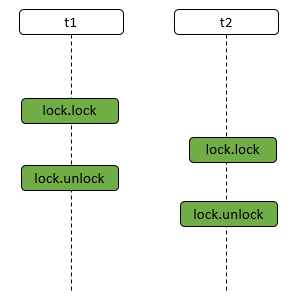
说明:首先线程t1先执行lock.lock操作,然后t2执行lock.lock操作,然后t1执行lock.unlock操作,最后t2执行lock.unlock操作。基于这样的时序,分析AbstractQueuedSynchronizer内部的工作机制。
① t1线程调用lock.lock函数,其函数调用顺序如下,只给出了主要的函数调用。
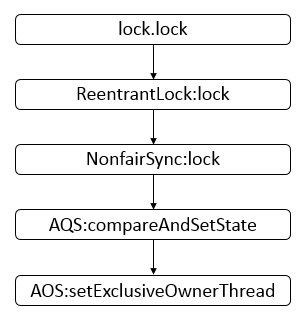
说明:其中,前面的部分表示哪个类,后面是具体的类中的哪个方法,AQS表示AbstractQueuedSynchronizer类,AOS表示AbstractOwnableSynchronizer类。
② t2线程调用lock.lock函数,其函数调用顺序如下,只给出了主要的函数调用。

说明:经过一系列的函数调用,最后达到的状态是禁用t2线程,因为调用了LockSupport.lock。
③ t1线程调用lock.unlock,其函数调用顺序如下,只给出了主要的函数调用。
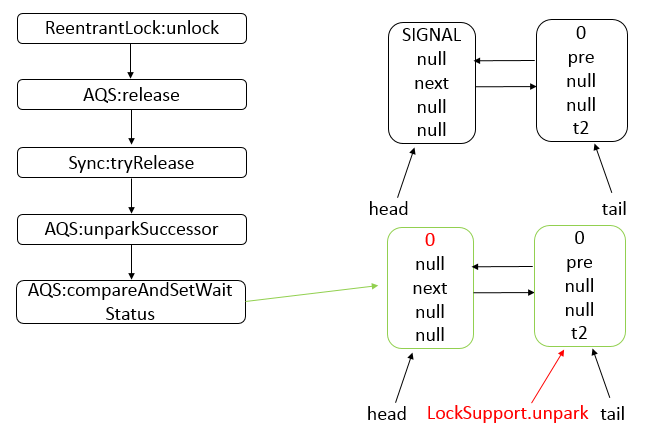
说明:t1线程中调用lock.unlock后,经过一系列的调用,最终的状态是释放了许可,因为调用了LockSupport.unpark。这时,t2线程就可以继续运行了。此时,会继续恢复t2线程运行环境,继续执行LockSupport.park后面的语句,即进一步调用如下。
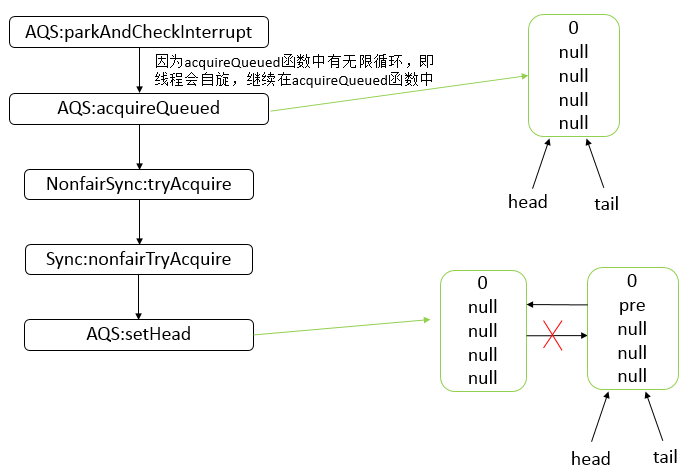
说明:在上一步调用了LockSupport.unpark后,t2线程恢复运行,则运行parkAndCheckInterrupt,之后,继续运行acquireQueued函数,最后达到的状态是头结点head与尾结点tail均指向了t2线程所在的结点,并且之前的头结点已经从sync队列中断开了。
④ t2线程调用lock.unlock,其函数调用顺序如下,只给出了主要的函数调用。

说明:t2线程执行lock.unlock后,最终达到的状态还是与之前的状态一样。
2. 示例二
下面我们结合Condition实现生产者与消费者,来进一步分析AbstractQueuedSynchronizer的内部工作机制。
Depot(仓库)类
1 package com.hust.grid.leesf.reentrantLock; 2 3 import java.util.concurrent.locks.Condition; 4 import java.util.concurrent.locks.Lock; 5 import java.util.concurrent.locks.ReentrantLock; 6 7 public class Depot { 8 private int size; 9 private int capacity; 10 private Lock lock; 11 private Condition fullCondition; 12 private Condition emptyCondition; 13 14 public Depot(int capacity) { 15 this.capacity = capacity; 16 lock = new ReentrantLock(); 17 fullCondition = lock.newCondition(); 18 emptyCondition = lock.newCondition(); 19 } 20 21 public void produce(int no) { 22 lock.lock(); 23 int left = no; 24 try { 25 while (left > 0) { 26 while (size >= capacity) { 27 System.out.println(Thread.currentThread() + " before await"); 28 fullCondition.await(); 29 System.out.println(Thread.currentThread() + " after await"); 30 } 31 int inc = (left + size) > capacity ? (capacity - size) : left; 32 left -= inc; 33 size += inc; 34 System.out.println("produce = " + inc + ", size = " + size); 35 emptyCondition.signal(); 36 } 37 } catch (InterruptedException e) { 38 e.printStackTrace(); 39 } finally { 40 lock.unlock(); 41 } 42 } 43 44 public void consume(int no) { 45 lock.lock(); 46 int left = no; 47 try { 48 while (left > 0) { 49 while (size <= 0) { 50 System.out.println(Thread.currentThread() + " before await"); 51 emptyCondition.await(); 52 System.out.println(Thread.currentThread() + " after await"); 53 } 54 int dec = (size - left) > 0 ? left : size; 55 left -= dec; 56 size -= dec; 57 System.out.println("consume = " + dec + ", size = " + size); 58 fullCondition.signal(); 59 } 60 } catch (InterruptedException e) { 61 e.printStackTrace(); 62 } finally { 63 lock.unlock(); 64 } 65 } 66 }
测试类
1 package com.hust.grid.leesf.reentrantLock; 2 3 class Consumer { 4 private Depot depot; 5 public Consumer(Depot depot) { 6 this.depot = depot; 7 } 8 9 public void consume(int no) { 10 new Thread(new Runnable() { 11 @Override 12 public void run() { 13 depot.consume(no); 14 } 15 }, no + " consume thread").start(); 16 } 17 } 18 19 class Producer { 20 private Depot depot; 21 public Producer(Depot depot) { 22 this.depot = depot; 23 } 24 25 public void produce(int no) { 26 new Thread(new Runnable() { 27 28 @Override 29 public void run() { 30 depot.produce(no); 31 } 32 }, no + " produce thread").start(); 33 } 34 } 35 36 public class ReentrantLockDemo { 37 public static void main(String[] args) throws InterruptedException { 38 Depot depot = new Depot(500); 39 new Producer(depot).produce(500); 40 new Producer(depot).produce(200); 41 new Consumer(depot).consume(500); 42 new Consumer(depot).consume(200); 43 } 44 }
运行结果(可能的一种):
produce = 500, size = 500 Thread[200 produce thread,5,main] before await consume = 500, size = 0 Thread[200 consume thread,5,main] before await Thread[200 produce thread,5,main] after await produce = 200, size = 200 Thread[200 consume thread,5,main] after await consume = 200, size = 0
说明:根据结果,我们猜测一种可能的时序如下
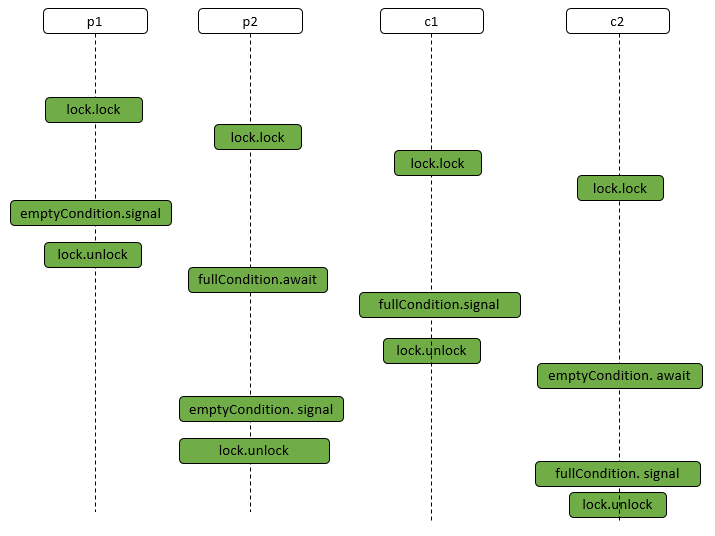
说明:p1代表produce 500的那个线程,p2代表produce 200的那个线程,c1代表consume 500的那个线程,c2代表consume 200的那个线程。
1. p1线程调用lock.lock,获得锁,继续运行,函数调用顺序在前面已经给出。
2. p2线程调用lock.lock,由前面的分析可得到如下的最终状态。

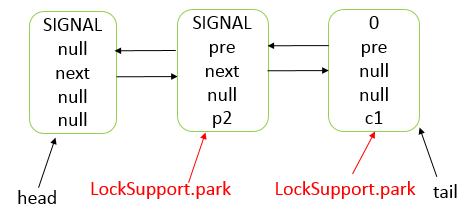
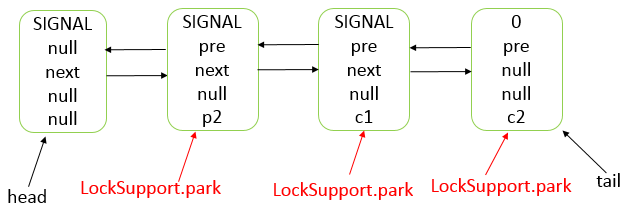
5. p1线程执行emptyCondition.signal,其函数调用顺序如下,只给出了主要的函数调用。

说明:AQS.CO表示AbstractQueuedSynchronizer.ConditionObject类。此时调用signal方法不会产生任何其他效果。
6. p1线程执行lock.unlock,根据前面的分析可知,最终的状态如下。

说明:此时,p2线程所在的结点为头结点,并且其他两个线程(c1、c2)依旧被禁止,所以,此时p2线程继续运行,执行用户逻辑。
7. p2线程执行fullCondition.await,其函数调用顺序如下,只给出了主要的函数调用。

说明:最终到达的状态是新生成了一个结点,包含了p2线程,此结点在condition queue中;并且sync queue中p2线程被禁止了,因为在执行了LockSupport.park操作。从函数一些调用可知,在await操作中线程会释放锁资源,供其他线程获取。同时,head结点后继结点的包含的线程的许可被释放了,故其可以继续运行。由于此时,只有c1线程可以运行,故运行c1。
8. 继续运行c1线程,c1线程由于之前被park了,所以此时恢复,继续之前的步骤,即还是执行前面提到的acquireQueued函数,之后,c1判断自己的前驱结点为head,并且可以获取锁资源,最终到达的状态如下。

说明:其中,head设置为包含c1线程的结点,c1继续运行。
9. c1线程执行fullCondtion.signal,其函数调用顺序如下,只给出了主要的函数调用。

说明:signal函数达到的最终结果是将包含p2线程的结点从condition queue中转移到sync queue中,之后condition queue为null,之前的尾结点的状态变为SIGNAL。
10. c1线程执行lock.unlock操作,根据之前的分析,经历的状态变化如下。

说明:最终c2线程会获取锁资源,继续运行用户逻辑。
11. c2线程执行emptyCondition.await,由前面的第七步分析,可知最终的状态如下。

说明:await操作将会生成一个结点放入condition queue中与之前的一个condition queue是不相同的,并且unpark头结点后面的结点,即包含线程p2的结点。
12. p2线程被unpark,故可以继续运行,经过CPU调度后,p2继续运行,之后p2线程在AQS:await函数中被park,继续AQS.CO:await函数的运行,其函数调用顺序如下,只给出了主要的函数调用。

13. p2继续运行,执行emptyCondition.signal,根据第九步分析可知,最终到达的状态如下。

说明:最终,将condition queue中的结点转移到sync queue中,并添加至尾部,condition queue会为空,并且将head的状态设置为SIGNAL。
14. p2线程执行lock.unlock操作,根据前面的分析可知,最后的到达的状态如下。

说明:unlock操作会释放c2线程的许可,并且将头结点设置为c2线程所在的结点。
15. c2线程继续运行,执行fullCondition. signal,由于此时fullCondition的condition queue已经不存在任何结点了,故其不会产生作用。
16. c2执行lock.unlock,由于c2是sync队列中最后一个结点,故其不会再调用unparkSuccessor了,直接返回true。即整个流程就完成了。
五、总结
对于AbstractQueuedSynchronizer的分析,最核心的就是sync queue的分析。
① 每一个结点都是由前一个结点唤醒
② 当结点发现前驱结点是head并且尝试获取成功,则会轮到该线程运行。
③ condition queue中的结点向sync queue中转移是通过signal操作完成的。
④ 当结点的状态为SIGNAL时,表示后面的结点需要运行。
当然,此次分析没有涉及到中断操作,如果涉及到中断操作,又会复杂得多,以后遇到这种情况,我们再进行详细分析,AbstractQueuedSynchronizer类的设计令人叹为观止,以后有机会还会进行分析。也谢谢各位园友的观看~
最后给出两篇参考链接
http://ifeve.com/introduce-abstractqueuedsynchronizer/
